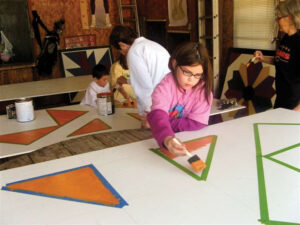 “Every day at least one person stops to look at my quilt square,” says Rodney Schwark of Kankakee County referring to the 8’x8’ board affixed to the side of his barn painted in a colorful red, white and blue pattern that forms a star. Positioned on the 1923 era farm building where it can be easily seen from the nearby country road, the patch of bright color is difficult to miss and easy to admire.
“Every day at least one person stops to look at my quilt square,” says Rodney Schwark of Kankakee County referring to the 8’x8’ board affixed to the side of his barn painted in a colorful red, white and blue pattern that forms a star. Positioned on the 1923 era farm building where it can be easily seen from the nearby country road, the patch of bright color is difficult to miss and easy to admire.
However, there are 49 more quilt squares in Kankakee County, too. Each is painted to match a different quilt pattern and they began appearing in 2005. Many represent an heirloom quilt owned by the farm family that owns the barn. Others are selected simply because the family liked the colors and design of a particular square, or because the name of the quilt pattern is meaningful in some manner.
“Our square was selected to honor our son who served in Desert Storm,” Schwark explains. “It is known by quilters as the patriot pattern because it forms a star.”
 Holly Froning at the Bourbonnais extension office of the University of Illinois says the idea to add colorful quilt squares to country barns originated when local photographers Clayton and Carolyn Spleer Pratt saw quilt barns in Iowa and thought the idea would be good for Kankakee County. “We decided we wanted to add ten a year until we had 50 spread out all over the county that would form a ‘quilt trail’ anyone can drive and enjoy,” Holly says. “We reached our goal in 2012.”
Holly Froning at the Bourbonnais extension office of the University of Illinois says the idea to add colorful quilt squares to country barns originated when local photographers Clayton and Carolyn Spleer Pratt saw quilt barns in Iowa and thought the idea would be good for Kankakee County. “We decided we wanted to add ten a year until we had 50 spread out all over the county that would form a ‘quilt trail’ anyone can drive and enjoy,” Holly says. “We reached our goal in 2012.”
Buildings decorated with a square in Kankakee County are at least 50 years old and able to be seen from a paved public road. In addition to barns, agriculture-related buildings were included such as corncribs and smoke houses. “We knew the quilt squares would draw attention to the buildings and we wanted people to learn about agriculture as a result of their interest in the squares,” she says.
The idea to add a quilt square on a barn began when Donna Sue Groves envisioned painting a snail’s trail quilt square on her family barn in Adams County, Ohio in 2001. It was meant to be a gesture honoring her mother, Nina Maxine Groves, and five generations of her family that have shared a love of quilting.
Conversation about the idea among Groves’ friends led her to suggest a “trail of quilt barns” people might enjoy. Enthusiasm was instantaneous and participation so quick soon there were 20 quilt squares on barns close to the Groves’ home. Photos and conversation about the idea soon spread to other counties in Ohio, then into other states. Quilt trails, like the one in Kankakee County, blossomed as quickly as a quilter buys fabric.
 Today there are 2,500 quilt barns in 44 states according to Suzi Parron author of Barn Quilts and the American Quilt Trail Movement (www.barnquiltinfo.com/), which she authored with Groves. The book, which covers quilt barns throughout the United States, features the Larson barn in Kankakee County on the cover.
Today there are 2,500 quilt barns in 44 states according to Suzi Parron author of Barn Quilts and the American Quilt Trail Movement (www.barnquiltinfo.com/), which she authored with Groves. The book, which covers quilt barns throughout the United States, features the Larson barn in Kankakee County on the cover.
“Prior to visiting Kankakee, I had taken over 1200 photos of barn quilts across the country and had already put aside about twenty for consideration for the cover,” she said recently. “But I left Kankakee knowing that this was the one!”
“I wanted the cover shot to be one that represented all of the hundreds of barn quilts-not just in appearance but also in spirit. The Larson family, who owns the property, is deeply proud of the farm itself and being part of the quilt trail.”
 There are several reasons for the nationwide popularity of quilt square barns. Volunteer groups that help paint and install the squares see them as an opportunity to contribute public art to the community in a fun and visible way. Local art classes that help paint get valuable lessons that help them understand color and design. Farmers view the squares as a way to get people into the countryside, share their love of the land, and perhaps honor someone in their own family.
There are several reasons for the nationwide popularity of quilt square barns. Volunteer groups that help paint and install the squares see them as an opportunity to contribute public art to the community in a fun and visible way. Local art classes that help paint get valuable lessons that help them understand color and design. Farmers view the squares as a way to get people into the countryside, share their love of the land, and perhaps honor someone in their own family.
Rural communities also realize an economic benefit from this unique form of agritourism. Froning says visitors, who otherwise would not be in the county, stop and shop, buy gasoline and eat in towns in the community. Schwark estimates 40 percent of the people he talks to do not live in Illinois. “Somehow they heard about our trail and stop on their way to a family reunion or an event,” he says.
 An unexpected benefit is that the building the quilt square is on receives attention and care that might not have occurred. Since each is at least a half-century old, this also helps preserve them as historically important buildings. “Even the most well-kept barnyard gets extra attention from the owner as soon as the quilt square goes up,” says Roberta Renville who has been involved with the Kankakee initiative since it began.
An unexpected benefit is that the building the quilt square is on receives attention and care that might not have occurred. Since each is at least a half-century old, this also helps preserve them as historically important buildings. “Even the most well-kept barnyard gets extra attention from the owner as soon as the quilt square goes up,” says Roberta Renville who has been involved with the Kankakee initiative since it began.
“In anticipation of installation of their quilt square several of our barn owners have had new roofs, siding and windows installed, and have painted the spot on the barn where the square will hang anticipating they will paint the entire barn at a later date. All are very proud of their homesteads and we love the idea that they are investing in preservation at the same time as they add a quilt square.”
Finally, the squares demonstrate pride in the rural origin of the area and have added a renewed sense of community to the county.
The cost of a quilt square originates from a variety of sources, including the farm owner. Community art grants, public and business donations and fundraising events have all been used to cover expenses. However, most of the effort to paint and hang each square is donated by volunteers.
To help visitors find their way along the Kankakee County quilt trail a colorful 16-page brochure is available with a trail map, a photograph of each square and short explanations why the pattern was chosen, as well as a history of the barn and farm. The county website also has a link to several videos of the Kankakee squares.
Each fall Kankakee County sponsors a quilt barn bus tour. Participants are greeted at each stop by the barn owner who talks about the square and the history of their farm. Other groups include bicycle tours, and retirement homes, which take residents along the trail.
Throughout the year Schwark enjoys greeting people who stop if he is home. “I have never had a problem,” he says. “But you would not expect someone interested in a quilt barn to be up to no good.”
Some square owners add their own touch to their pattern. Examples include the Warner Diefenbach barn where visitors are asked to sign a guest book, and a changing seasonal display under the square at the Larson farm. The Rosenboom barn is painted to fool the eye. It appears, folds and all, as if it is an actual quilt hanging in the sun. Schwark’s square is lit each evening until 11 p.m.
Meanwhile Groves is thrilled at the “countrywide clothesline of quilts” she started, but she is quick to mention that she hopes each barn owner knows the idea was to honor her mother, and that they do the same for the women in their family.
Photos courtesy Kankakee County Barn Quilt Committee







